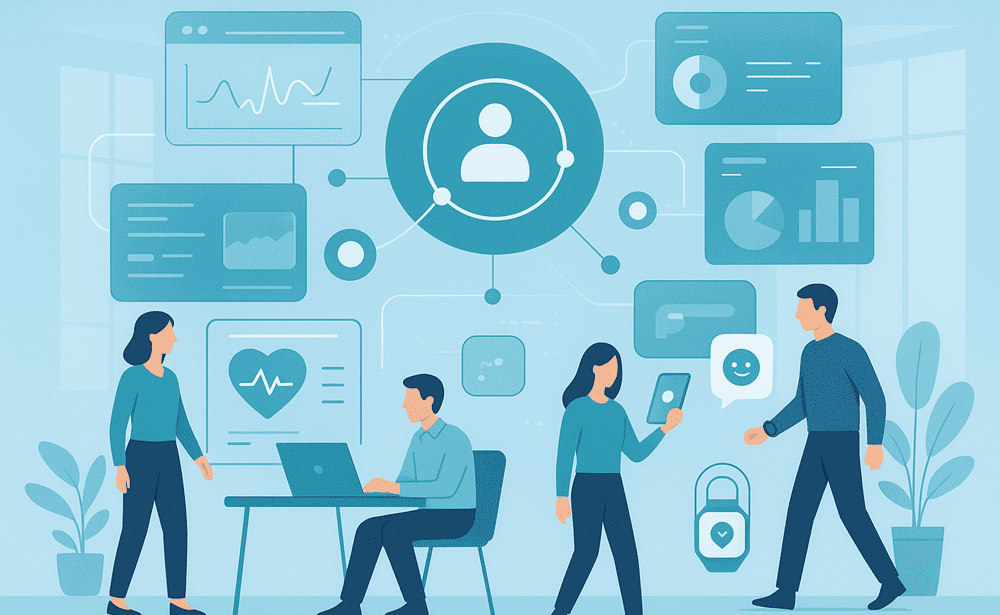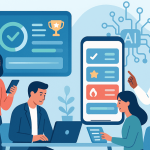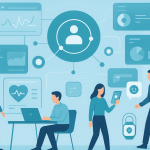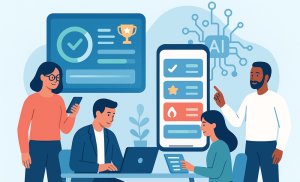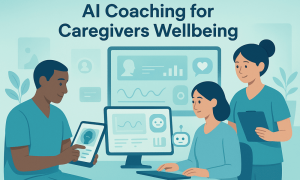Building a healthy workplace used to rely on scattered tools, occasional surveys, and once-a-year wellness programs. Today, organizations are shifting toward something far more connected. an AI wellness ecosystem that brings physical, emotional, and social wellbeing into one continuous, data-supported flow.
Instead of treating wellness like a side project, companies are now using holistic wellness AI and intelligent platforms that work together in the background, helping employees stay balanced while giving leaders clearer visibility into workplace health. This new ecosystem model is changing how corporate teams understand wellbeing, how support is delivered, and how employees interact with daily health habits.
Why Organizations Are Moving Toward an AI Wellness Ecosystem
Modern workplaces are fast, distributed, and overloaded with communication. Employees face growing burnout, loneliness, and fatigue—yet traditional programs rarely offer real-time support. That’s where an AI wellbeing platform steps in, offering connected insights and a steady flow of nudges, check-ins, and coaching moments.
Leaders using tools such as AI for HR can finally move beyond reactive wellness planning.
Most importantly, this isn’t a single app or dashboard. It’s a network of tools—wearables, smart coaching systems, mood trackers, wellbeing analytics, and digital health apps—all working together through AI.
What Makes an AI Wellness Ecosystem Different?
A true ecosystem doesn’t just collect information. It links physical signals, emotional cues, and social interactions into one responsive system. With smart wellbeing analytics, organizations can see patterns that were impossible to track before.
Here’s what sets an ecosystem apart:
Key Characteristics of an AI Wellness Ecosystem
| Feature | How It Helps Employees | How It Helps Organisations |
| Connected data streams | Tracks stress, sleep, movement, mood | Provides accurate workforce trends |
| Real-time insights | Relevant tips during long workdays | Timely interventions instead of guesswork |
| Personalized coaching | Practical routines and coping skills | Programs tailored by department/team |
| Social wellbeing tools | Builds community and inclusiveness | Reduces isolation and turnover |
The way companies implement these insights is slowly shifting workplace culture. For example, mid-sized organizations using AI wellbeing dashboards have seen up to a 22% improvement in participation in wellbeing programs (based on aggregated HR tech reports from 2025).
Connecting Physical Wellbeing Through AI
Physical health still forms the foundation of employee performance. But instead of weekly check-ins or long reports, the AI wellness ecosystem makes physical wellbeing easy to monitor and understand in real time. Wearables and digital health tools pick up micro-patterns—sleep irregularities, extended sedentary time, heart-rate shifts during stressful work periods.
A retail operations team in the US, for instance, noticed that employees on rotating shifts were consistently reporting low energy. After analyzing data through a digital health ecosystem, managers adjusted schedules and added recovery-focused microbreaks. This resulted in fewer sick days and better shift satisfaction.
These insights can seamlessly integrate into leadership workflows, especially when paired with AI coaching for leaders.
Supporting Emotional Health With AI Tools
Emotional wellbeing is often overlooked because employees hesitate to share stress, frustration, or fatigue. AI can help by offering neutral, nonjudgmental touchpoints.
Through small check-ins, mood prompts, personalized reflections, and guided breathing sessions, platforms powered by holistic wellness AI help employees express how they feel—especially those who usually stay silent. These micro-moments create emotional clarity and reduce pressure.
Behavioral studies show that employees who engage in daily prompts are 35–40% more likely to report improved mood stability after eight weeks. Organizations can reinforce these gains by connecting such tools to AI emotional check-ins that relate to broader team wellbeing insights.
Strengthening Social Connections Through Digital Wellness
Social health is often the missing link in corporate wellbeing. Loneliness at work is rising, especially in hybrid teams. AI can help by identifying low-engagement patterns and encouraging meaningful social interactions.
Examples include:
- Interest-based groups suggested by AI
- Micro-activities that prompt team collaboration
- Recognition moments triggered by peer data
- Alerts when certain groups become isolated
The AI wellness ecosystem makes workplace relationships measurable—without invading privacy—so employers understand what helps teams feel connected. This also aligns with growing demand for corporate health tech that improves real team dynamics.
These social insights often guide how wellness programs evolve and support broader wellbeing journeys, especially when connected to corporate wellbeing AI.
How the Ecosystem Works Beneath the Surface
Even though employees see simple nudges or prompts, several components operate behind the scenes:
1. Data Inputs
- Wearables
- HR systems
- Wellbeing surveys
- Communication apps
- Digital health records (where applicable)
- Wellness challenges
2. AI Processing Layer
This layer analyzes stress indicators, behavior patterns, social signals, and environmental factors. It recognizes early warning signs—like digital fatigue or signs of social isolation.
3. Insights & Nudges
Employees receive small, timely prompts. Leaders see trends that help them design better wellness policies.
4. Feedback Loop
The ecosystem learns how individuals respond and adjusts recommendations. For example, if a manager consistently ignores lunchtime breaks, the system may switch to alternate methods like calendar suggestions or short mindfulness reminders.
This adaptive flow shows why an integrated wellbeing platform is more effective than standalone tools.
Business Value: Why Companies Are Embracing the AI Wellness Ecosystem
Corporate owners are prioritizing wellbeing because poor health directly impacts productivity, retention, and culture. According to multiple surveys from Deloitte, McKinsey, and Gartner:
- 60% of employees say their workplace stress affects their physical health.
- 45% of managers feel they lack tools to support emotional wellbeing in their teams.
- Companies with structured wellbeing programs see up to 3x higher engagement.
The AI wellness ecosystem gives businesses a scalable, cost-efficient approach to support employees without adding excessive workload.
Below are a few business benefits:
1. Reduced Burnout
AI can detect burnout patterns early through digital behavior, sleep signals, and subtle mood changes.
2. Better Decision-Making
Leaders can track team health trends through advanced analytics, often connected to AI wellbeing dashboards.
3. Higher Retention
When workers feel supported—physically, emotionally, socially—they stay longer and perform better.
4. Stronger Culture
AI helps reinforce healthy habits that strengthen trust and communication.
Real Workplace Examples
Case Example 1: Financial Services Company
A financial firm used smart wellbeing analytics across 700 employees. They discovered that teams working with client escalations had twice the emotional fatigue rate. After implementing regular breaks, calming prompts, and micro-coaching, they saw:
- 28% decrease in burnout markers
- 17% improvement in self-reported satisfaction
- 12% reduction in sick leave
One department even used AI coaching for leaders to guide conversations around workload redistribution.
Case Example 2: Technology Company
A tech company integrated a digital health ecosystem to track sleep, movement, and social engagement. Within six months:
- Physical activity rose by 22%
- Workplace loneliness fell by nearly 30%
- Employee-reported stress dropped by 18%
The organization used these insights along with AI emotional check-ins to redesign their hybrid meeting schedules.
Future: What’s Next for Workplace Wellness Ecosystems
The next few years will bring deeper integration between:
- Wearables
- Digital biomarker technology
- Predictive analytics
- Personalized coaching models
- Intelligent HR systems
AI may soon be able to spot burnout risk weeks before it impacts performance, or identify social disconnect in hybrid teams based on communication patterns.
More organizations are also shifting toward unified platforms instead of single-purpose apps, increasing interest in corporate health tech that covers physical, emotional, and social wellbeing in one place.
Leaders who adopt these tools early—especially those using AI for HR will create environments where employees feel supported every day, not just during wellness campaigns.
Conclusion
Workplace wellness has moved far beyond fitness challenges and occasional mental health sessions. The AI wellness ecosystem gives organizations a connected, intelligent approach that reflects how people actually live and work. It links physical signals, emotional patterns, and social connections to build healthier, more resilient teams.
For corporate owners looking to create a supportive, high-performing culture, this ecosystem model offers clarity, structure, and long-term sustainability. And as AI continues advancing, wellness will become more personalized, more timely, and more impactful than ever.

